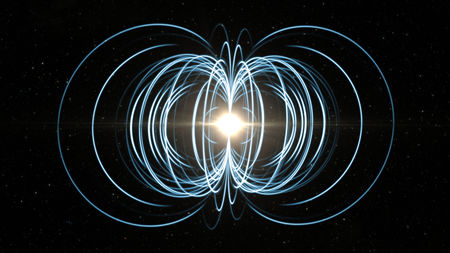Magnetars are neutron stars with magnetic fields 100 million times stronger than that of any magnet on Earth.
© Pitris/Dreamstime.com
On 28 April, as Earth’s rotation swept a Canadian radio telescope across the sky, it watched for mysterious millisecondslong flashes called fast radio bursts (FRBs). At 7:34 a.m. local time an enormous one appeared, but awkwardly, in the peripheral vision of the scope. “It was way off the edge of the telescope,” says Paul Scholz, an astronomer at the University of Toronto and a member of the Canadian Hydrogen Intensity Mapping Experiment (CHIME). Because of its brightness, the team knew its source was nearby. All other FRBs seen so far have erupted in distant galaxies—too far and too fast to figure out what produced them.
The team had a hunch about this one. In previous days, orbiting telescopes had witnessed a Milky Way magnetar—a neutron star with a powerful magnetic field—flinging out bursts of x-rays and gamma rays. The turmoil suggested it might be pulsing with radio waves, too. After some extra data processing, the team determined the FRB was “definitely colocated” with the magnetar, Scholz says. “We were really excited.”
The find, announced in a paper posted to the arXiv preprint server on 20 May, could be the missing link in a problem that has puzzled astronomers for more than a decade. It’s only a single event and many questions remain, including why this burst was 30 times less energetic than the weakest FRB traced to another galaxy. Yet astronomers are increasingly confident that some, if not all, of these laserlike radio flashes originate from magnetars, collapsed stars with magnetic fields 100 million times stronger than any magnet made on Earth. A magnetar origin would rule out more exotic sources such as supermassive black holes and merging neutron stars. “The game of alternative theories is becoming more and more difficult,” says theorist Maxim Lyutikov of Purdue University. “For the majority, it’s a decided question: It’s magnetars.”
The first FRB was detected in 2007, and astronomers have tallied a little over 100 since then. Their brevity makes them hard to study or trace to a particular celestial object. But several FRBs have been found to repeat, giving astronomers a chance to identify their host galaxy. And in the past year or two, wide-field telescopes such as CHIME, designed to survey large swaths of the sky, have begun to boost the number of detections substantially.
Another wide-field telescope, the Survey for Transient Astronomical Radio Emission 2—three radio antennas scattered across the western United States—also spotted the 28 April burst and measured its energy, according to a second preprint, posted to arXiv on 21 May. Deepening the mystery, its proposed source, a magnetar called SGR 1935+2154, is “nothing special,” Lyutikov says. Only five of the 30 known magnetars in the Milky Way have been seen to emit weak radio signals, and SGR 1935+2154 is not one of them.
Yet theorists are already jostling to explain how a magnetar could power an FRB. Brian Metzger of Columbia University and colleagues had earlier proposed a model in which magnetars emit frequent bursts of near–light-speed particles, akin to the great puffs of plasma the Sun belches in coronal mass ejections. When a burst slams into material emitted earlier, it creates a shock wave that causes electrons to spiral around magnetic field lines, generating a powerful laserlike radio pulse. Metzger’s group had not applied its model to something as weak as SGR 1935+2154, but when it did, “it worked OK,” he says. The team’s model, Metzger says, can also explain why the magnetar’s x-ray pulse was 100,000 times more energetic than its radio one.
Lyutikov believes the action occurs much closer, near the magnetar’s surface. In 2002—years before the discovery of the first FRBs—he proposed an engine based on magnetic reconnection, in which field lines break and reconnect in new configurations. On the surface of the Sun, the phenomenon drives powerful flares. On a neutron star, Lyutikov says, it could generate the nearly simultaneous bursts of both x-rays and radio waves seen from SGR 1935+2154, although it does not yet account for the laserlike beaming.
“Pretty much every modeler who had previously considered how magnetars could generate an FRB has now said, within days, that they are right,” says Victoria Kaspi, an astronomer at McGill University and a CHIME leader. “They can’t all be right.”
Observers are now training their telescopes toward nearby galaxies hoping to catch more flyweight FRBs. Although the 28 April flash was puny compared with most extragalactic FRBs, it does at least show that magnetars are capable of something more dramatic than their usual feeble radio signals. “This goes a long way to bridging that gap,” says Jason Hessels of the University of Amsterdam. “It all seems a lot more plausible now.”

























